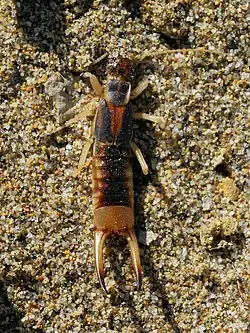Labidura
| Labidura Temporal range: Eocene-Quaternary
| |
|---|---|

| |
| Labidura riparia | |
| Scientific classification | |
| Kingdom: | Animalia |
| Phylum: | Arthropoda |
| Class: | Insecta |
| Order: | Dermaptera |
| Family: | Labiduridae |
| Subfamily: | Labidurinae |
| Genus: | Leach, 1815 |
| Species | |
|
See text | |
| Synonyms | |
| |
Labidura is a genus of earwigs in the family Labiduridae.[1] Probably the earliest specimen of Labidura was found in Eocene amber.[2] Among the Labidura species, Labidura riparia is cosmopolitan, but the Saint Helena earwig (Labidura herculeana) was the largest of all earwigs before its possible extinction after the year of 1967.[3][4]
Species
The genus contains the following species:[1]
- Labidura cryptera Liu, 1946
- Labidura dharchulensis Gangola, 1968
- Labidura elegans Liu, 1946
- Labidura japonica (Haan, 1842)
- Labidura minor Boeseman, 1954
- Labidura orientalis Steinmann, 1979
- Labidura riparia (Pallas, 1773)
- Labidura xanthopus (Stal, 1855)
- †Labidura herculeana (Fabricius, 1798)
References
- ^ a b "genus Labidura Leach, 1815". Dermaptera Species File. Retrieved 17 January 2017.
- ^ M. Burr. 1911. Dermaptera (earwigs) preserved in amber, from Prussia. Transactions of the Linnean Society of London, Second Series: Zoology 11:145-150
- ^ "Labidura". St Helena and Ascension Island Natural History. Archived from the original on 17 July 2011. Retrieved 5 February 2011.
- ^ Matt Walker (2014-11-17). "World's largest earwig is declared extinct". BBC Earth. Archived from the original on 2017-05-01. Retrieved 2017-05-16.